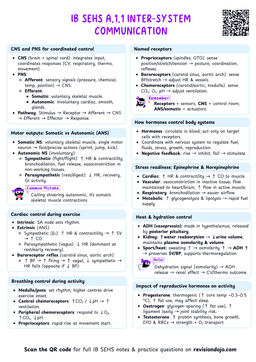Respiratory system and gas exchange
- The respiratory system plays a critical role in enabling the exchange of gases (primarily oxygen and carbon dioxide) between the external environment and the body.
- This exchange facilitates cellular respiration, a process that provides the energy required for cellular functions.
Structure of the Respiratory system
The respiratory system is made up of the following structures:
- Nose and Mouth: Air enters the body through the nose or mouth, where it is warmed, moistened, and filtered.
- Pharynx: A shared pathway for air and food.
- Larynx: Contains the vocal cords and connects the pharynx to the trachea.
- Trachea: A tube that carries air to the lungs, supported by cartilage rings.
- Bronchi: The trachea divides into two bronchi, one for each lung.
- Bronchioles: Smaller branches of the bronchi that lead to the alveoli.
- Alveoli: Tiny air sacs where gas exchange occurs.
- Diaphragm: A muscle that helps control breathing by changing the volume of the thoracic cavity.
Alveoli
Alveoli are tiny, balloon-like structures that are the primary site for the exchange of gases (O₂ and CO₂). They provide a large surface area for gas exchange due to their many folds.

Gas Exchange: O₂ and CO₂ Transport
Gas exchange refers to the movement of oxygen and carbon dioxide across the alveolar membrane into and out of the blood.
Process of Gas Exchange
- Inhalation: Air rich in oxygen enters the body through the nose/mouth and travels through the pharynx, larynx, trachea, bronchi, and bronchioles.
- Alveoli: The bronchioles lead to tiny air sacs called alveoli. Here, oxygen from the inhaled air diffuses across the thin walls of the alveoli into the capillaries that surround them.
- Diffusion: Oxygen moves from the high-concentration area (air in the alveoli) to the low-concentration area (blood in the capillaries). Conversely, carbon dioxide, which is in higher concentration in the blood, diffuses from the blood into the alveoli to be exhaled.
- Exhalation: The body expels carbon dioxide from the lungs back into the atmosphere through the same pathway.

- Gas exchange is the process of oxygen entering the blood and carbon dioxide leaving the blood.
- It occurs in the alveoli of the lungs.
- Think of alveoli as small balloons.
- When you inhale, they expand with air (oxygen), and when you exhale, they deflate and release waste gases (carbon dioxide).
- In high-altitude environments, the lower oxygen concentration reduces diffusion efficiency, leading to breathlessness.
- Athletes often train at high altitudes to adapt to lower oxygen levels and improve performance.
Functions of the Respiratory System
The respiratory system has several important functions:
- Gas Exchange: Oxygen is taken in from the air and carbon dioxide is expelled.
- Regulation of Blood pH: By controlling the levels of carbon dioxide, the respiratory system helps maintain the acid-base balance in the blood.
- Protection: The respiratory system filters out dust, pathogens, and other particles from the air.
- Sound Production: The larynx contains the vocal cords, which produce sound when air passes through them.
The respiratory system works closely with the circulatory system to transport oxygen to the body cells and remove carbon dioxide.
Key Parameters in Respiratory Function
The body adapts to different levels of activity and physical demands by adjusting several key parameters of the respiratory system, including:
- Minute Ventilation (VE)
- Tidal Volume (TV)
- Respiration Rate (RR)
Minute Ventilation
Minute ventilation
Minute ventilation is the total volume of air that is inspired or expired from the lungs per minute.
Minute ventilation is an essential measure of lung function because it determines how effectively oxygen is delivered to the blood and how efficiently carbon dioxide is removed.
Minute ventilation is calculated using the formula:
$$\text{Minute Ventilation (VE)} = \text{Tidal Volume (VT)} \times \text{Respiratory Rate (RR)}$$
Where:
- Tidal Volume (VT) is the volume of air inhaled or exhaled in a single breath.
- Respiratory Rate (RR) is the number of breaths taken per minute.
- Minute ventilation is a major determinant of endurance performance.
- Athletes with higher VE can deliver more oxygen to working muscles and clear CO₂ more efficiently, delaying fatigue.
Influence of Activity
- During Exercise: Minute ventilation increases significantly as the body requires more oxygen for energy production and needs to expel more carbon dioxide as a waste product.
- During Intense Activity: Tidal volume increases (deeper breaths) and respiration rate increases (faster breathing), leading to a higher minute ventilation. This ensures that the muscles are sufficiently supplied with oxygen to sustain energy production and remove CO₂.
Factors Influencing Minute Ventilation
- Age: As individuals age, their lung capacity and ability to increase minute ventilation during exercise may decrease.
- Fitness Level: Athletes tend to have a higher minute ventilation during exercise due to better pulmonary efficiency and the ability to breathe more deeply (higher tidal volume).
- Activity Type and Intensity: Aerobic exercises (such as running or cycling) increase minute ventilation more significantly than activities like weightlifting, which rely more on anaerobic energy pathways.
- Think of minute ventilation like the capacity of a pump that draws in and expels air.
- During exercise, the pump works harder and faster to meet the demands of the body.


